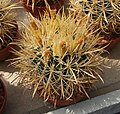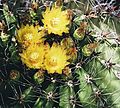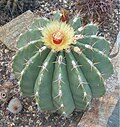| Section | Image | Scientific name | Common name | Distribution |
|---|
| Section Bisnaga |  | Ferocactus echidne | Sonora Barrel Cactus, Coville's Barrel Cactus, Emory's Barrel Cactus, Traveler's Friend | Mexico |
|---|
 | Ferocactus flavovirens | | Mexico. |
 | Ferocactus glaucescens | | Hidalgo, México. |
 | Ferocactus haematacanthus (Salm-Dyck) Bravo ex Backeb. & F.M.Knuth [3] | | Mexico. |
 | Ferocactus hamatacanthus (Muehlenpf.) Britton & Rose | Turk's-Head Barrel Cactus, Biznaga-barril Costillona | Chihuahuan Desert of north-western Mexico, New Mexico, and south-western Texas. |
 | Ferocactus histrix (DC.) G.E.Linds. | Electrode Cactus | Mexico. |
 | Ferocactus latispinus (Haw.) Britton & Rose | | southeastern Durango, through Zacatecas, Aguascalientes, east to the western parts of San Luis Potosí, Hidalgo and Puebla, as well as to eastern Jalisco, Guanajuato, Querétaro and Mexico State. |
 | Ferocactus lindsayi | | Mexico (Michoacán, Guerrero) |
 | Ferocactus macrodiscus | | Mexico. |
 | Ferocactus schwarzii | Schwarz's Barrel Cactus | Mexico. |
| Section Ferocactus |  | Ferocactus alamosanus | | Mexican state of Sonora, in northwestern Mexico |
|---|
 | Ferocactus chrysacanthus | | Mexico. |
 | Ferocactus cylindraceus (Engelm.) Orcutt | California Barrel Cactus, Biznaga-barril cilíndrica | eastern Mojave Desert and western Sonoran Desert Ecoregions in: Southern California, Nevada, Arizona, and Utah in the Southwestern United States; and Baja California, and Sonora state in Northwestern Mexico. |
 | Ferocactus diguetii | | Mexico. |
 | Ferocactus emoryi (Engelm.) Orcutt | Emory's Barrel Cactus, Biznaga-barril de Emory | Mexico (Sonora, Sinaloa and Baja California Sur) and in the United States (Arizona). |
 | Ferocactus fordii | | Baja California in Mexico. |
 | Ferocactus gracilis H.E.Gates | Fire Barrel Cactus | Mexico. |
 | Ferocactus herrerae | Twisted Barrel Cactus | Mexico (Sinaloa, Sonora) |
 | Ferocactus johnstonianus Britton & Rose | Johnston's Barrel Cactus | Angel de la Guardia Island, Baja California, Mexico. |
 | Ferocactus mathssonii | | Mexico (Guanajuato to San Luis Potosí) |
 | Ferocactus peninsulae (F.A.C.Weber) Britton & Rose | | Mexican state of Baja California Sur. |
 | Ferocactus pilosus | Mexican Lime Cactus, Viznaga de Lima | Méxican states of Coahuila, Durango, Nuevo Leon, San Luis Potosí, and Tamaulipas |
 | Ferocactus pottsii | | Mexico. |
 | Ferocactus robustus | | Puebla and Veracruz in Mexico. |
 | Ferocactus santa-maria | Santa-Maria Barrel Cactus | Mexico. |
| Ferocactus tiburonensis | | Mexico (Gulf of California: Tiburon Island) |
 | Ferocactus townsendianus | Townsend Barrel Cactus | Mexico. |
 | Ferocactus uncinatus (Galeotti) Britton & Rose | | Mexico, New Mexico, Texas |
 | Ferocactus viridescens (Torr. & A.Gray) Britton & Rose | San Diego Barrel Cactus, Biznaga-barril Verdosa | northern Baja California, Mexico and California |
 | Ferocactus wislizeni (Engelm.) Britton & Rose | Fishhook Barrel Cactus, Candy Barrel Cactus, Biznaga-barril de Nuevo México [3] [4] | southwestern United States and northwestern Mexico. |
|































